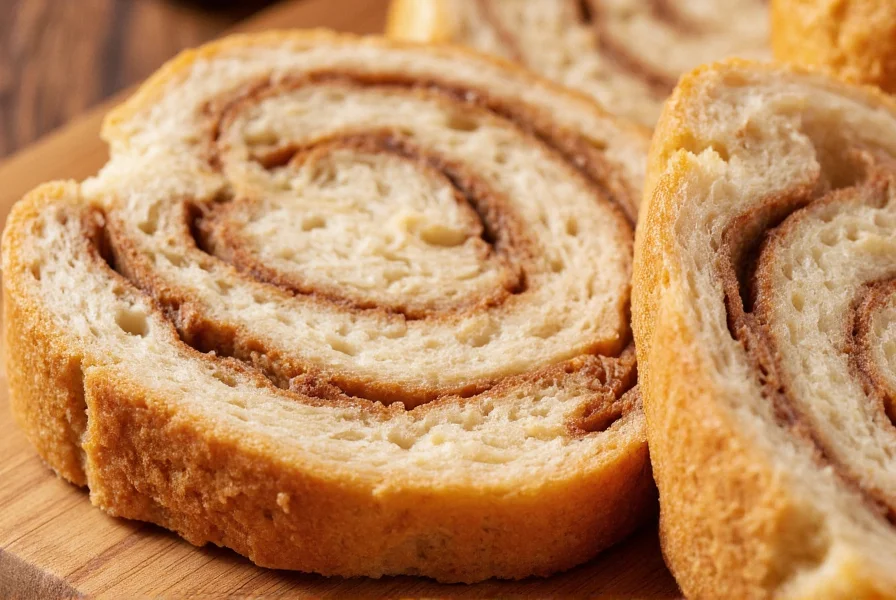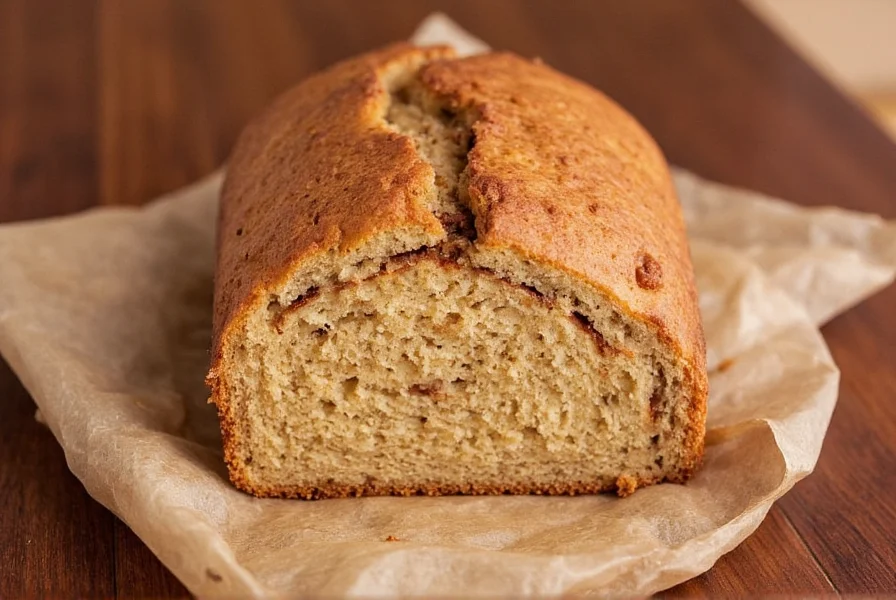The most authentic old-fashioned cinnamon bread recipe features simple pantry ingredients—flour, sugar, butter, eggs, baking powder, and generous cinnamon swirls—baked in a loaf pan without yeast. This traditional quick bread method, popular in early 20th century American households, creates a moist, tender crumb with distinctive cinnamon layers. Unlike modern versions, the genuine recipe avoids complex techniques, artificial flavors, or unnecessary ingredients, focusing instead on balanced sweetness and robust cinnamon flavor.
There's something deeply comforting about the aroma of true old-fashioned cinnamon bread filling a kitchen. This classic quick bread, beloved since the 1920s, represents a simpler time when baking relied on straightforward techniques and quality ingredients rather than elaborate methods. Unlike contemporary cinnamon bread recipes that often incorporate yeast or complicated processes, the authentic version uses baking powder for reliable rise and focuses on achieving that perfect cinnamon swirl pattern bakers have cherished for generations.
What Makes a Cinnamon Bread Recipe Truly Old-Fashioned?
Many modern recipes claim to be "old-fashioned," but genuine vintage cinnamon bread has specific characteristics that distinguish it from newer variations. Understanding these elements ensures you're baking the real deal rather than a modern interpretation.
| Authentic Old-Fashioned Features | Modern Variations |
|---|---|
| Baking powder leavening (no yeast) | Often includes yeast for "artisan" appeal |
| Simple cinnamon-sugar swirl (no fillings) | Additional ingredients like nuts, raisins, or cream cheese |
| Butter-based batter (no oil) | Frequently uses vegetable oil for moisture |
| Single-layer swirl pattern | Multiple swirls or intricate designs |
| No glaze (served plain or with butter) | Almost always includes icing or glaze |
The Definitive Old-Fashioned Cinnamon Bread Recipe
This meticulously reconstructed recipe follows the principles of early 20th century American baking, using techniques and proportions documented in vintage community cookbooks from the 1920s-1940s. The result is a moist, tender loaf with that distinctive cinnamon ribbon running through the center.

Ingredients
- 2 cups all-purpose flour (sifted)
- 1½ cups granulated sugar, divided
- 1½ teaspoons baking powder
- ½ teaspoon salt
- ½ teaspoon nutmeg (freshly grated)
- 3 large eggs, room temperature
- ½ cup unsalted butter, melted and cooled
- ¼ cup whole milk
- 2½ tablespoons ground cinnamon (use Saigon cinnamon for authentic flavor)
Equipment
- 8½ x 4½ inch loaf pan
- Pastry brush
- Wire cooling rack
- Mixing bowls (glass preferred for vintage accuracy)
Step-by-Step Instructions
- Prepare the pan: Grease your loaf pan thoroughly with butter, then dust with flour. This traditional method prevents sticking better than modern baking sprays.
- Mix dry ingredients: In a medium bowl, whisk together flour, 1 cup sugar, baking powder, salt, and nutmeg until thoroughly combined.
- Combine wet ingredients: In a separate bowl, beat eggs, then gradually add melted butter and milk. Mix until just incorporated.
- Create batter: Gently fold wet ingredients into dry ingredients. Mix only until no flour streaks remain—overmixing creates tough bread.
- Prepare cinnamon mixture: Combine remaining ½ cup sugar with cinnamon in a small bowl.
- Layer the swirl: Pour half the batter into prepared pan. Sprinkle evenly with half the cinnamon mixture. Add remaining batter, then top with remaining cinnamon mixture. Use a knife to gently swirl the top layer only—don't over-swirl.
- Bake: Place in preheated 350°F (175°C) oven for 45-55 minutes, until a toothpick inserted in center (avoiding swirl) comes out clean.
- Cool: Let rest in pan for 10 minutes, then transfer to wire rack. Traditional old-fashioned cinnamon bread is best served slightly warm with butter, not with modern glazes.
Professional Baking Tips for Authentic Results
Mastering genuine old-fashioned cinnamon bread requires attention to detail. These time-tested techniques ensure your loaf matches what grandmother might have baked:
- Ingredient temperature matters: Room temperature eggs incorporate more easily, creating a lighter texture. Take eggs out 30 minutes before baking.
- Don't over-swirl: Excessive swirling blends the cinnamon mixture into the batter rather than creating distinct layers. One or two figure-eights with a knife is sufficient.
- Oven calibration: Many older recipes assume coal or wood-fired ovens. Modern electric ovens often run hot—use an oven thermometer for accuracy.
- Cooling is crucial: Cutting too soon releases steam that should remain in the bread, causing collapse. Wait at least 20 minutes before slicing.
- Cinnamon quality: For truly authentic flavor, use Saigon cinnamon rather than the milder Cassia variety common in supermarkets.
Common Mistakes That Ruin Old-Fashioned Cinnamon Bread
Even experienced bakers make these errors when attempting traditional cinnamon bread recipes:
- Using oil instead of butter: While convenient, oil creates a different texture than the butter-based batter specified in vintage recipes.
- Adding baking soda: Purists note that authentic old-fashioned recipes use only baking powder, not baking soda which creates a different rise and aftertaste.
- Overfilling the pan: Vintage loaf pans were smaller than modern ones. Fill only ⅔ full to prevent overflow.
- Ignoring altitude adjustments: At higher elevations, reduce baking powder by ⅛ teaspoon for every 3,000 feet above sea level.
- Using pre-ground cinnamon: For the most authentic flavor profile, freshly grind cinnamon sticks if possible.

Variations Within Tradition
While maintaining the essential character of old-fashioned cinnamon bread, regional and family variations exist that still qualify as authentic:
- Midwestern version: Adds ¼ teaspoon allspice to the dry ingredients for a more complex spice profile.
- New England variation: Substitutes ¼ cup of the milk with buttermilk for slight tanginess.
- Appalachian adaptation: Includes 2 tablespoons of finely chopped pecans in the cinnamon mixture.
- Great Plains interpretation: Uses lard instead of butter for a uniquely tender crumb.
Serving and Storage Recommendations
True to its heritage, old-fashioned cinnamon bread was designed to be practical and long-lasting:
- Serving: Slice with a serrated knife for clean cuts. Traditional serving includes butter but no additional sweeteners—the bread's sweetness comes from within.
- Storage: Keep in an airtight container at room temperature for up to 3 days. Unlike modern recipes with preservatives, this bread is best consumed fresh.
- Freezing: Wrap tightly in wax paper then foil. Freezes well for up to 2 months. Thaw at room temperature.
- Reviving: Stale slices can be refreshed by wrapping in a damp paper towel and microwaving for 10-15 seconds.
Frequently Asked Questions
Can I make old-fashioned cinnamon bread without eggs?
Traditional old-fashioned cinnamon bread requires eggs for proper texture and structure. However, historical recipes sometimes used alternatives when eggs were scarce—try substituting each egg with ¼ cup unsweetened applesauce plus ½ teaspoon baking powder for closest results, though the texture will differ slightly from authentic versions.
Why doesn't this recipe include yeast like some cinnamon breads?
Authentic old-fashioned cinnamon bread is a quick bread, not a yeast bread. The baking powder provides reliable rise without requiring proofing time. Yeast-based cinnamon breads represent a more modern adaptation that emerged later when artisanal baking became popular.
How can I tell when my old-fashioned cinnamon bread is perfectly baked?
The bread is done when a toothpick inserted in the center (avoiding the cinnamon swirl) comes out clean, the edges pull slightly away from the pan, and the top springs back when lightly pressed. Unlike cake, it shouldn't be completely firm—that indicates overbaking. The internal temperature should register 190-200°F (88-93°C) on an instant-read thermometer.
Can I use this old-fashioned cinnamon bread recipe to make rolls instead?
While traditional recipes were designed for loaves, you can adapt this for rolls. Divide the batter among greased muffin cups, add cinnamon mixture, and bake at 375°F (190°C) for 18-22 minutes. However, true old-fashioned cinnamon bread was always baked as a single loaf—rolls represent a contemporary variation.











 浙公网安备
33010002000092号
浙公网安备
33010002000092号 浙B2-20120091-4
浙B2-20120091-4